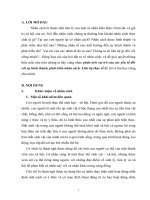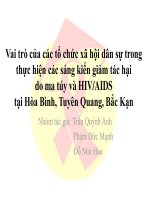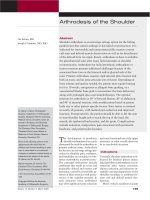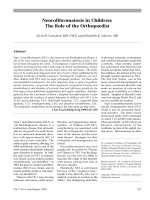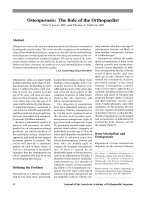Vai trò của các bác sĩ phẫu thuật chỉnh hình docx
Bạn đang xem bản rút gọn của tài liệu. Xem và tải ngay bản đầy đủ của tài liệu tại đây (113.76 KB, 7 trang )
Vol 10, No 1, January/February 2002
25
Elder abuse is a pervasive social and
medical problem that is suspected to
be a major source of morbidity and
mortality. In recent years, the num-
ber of reports of elder abuse has
risen as a result of greater family
involvement in caregiving relation-
ships with the elderly as well as the
increase in the number of elderly
persons with chronic debilitating
diseases.
1
Because of the increasing
public outcry about the widespread
public health problem of elder
abuse, all states now have abuse
laws that are specific for older
adults, and most states mandate
reporting of elder abuse by health-
care professionals. However, physi-
cians infrequently report elder abuse
for a number of reasons, among
them lack of familiarity with the
reporting laws, fear of offending pa-
tients or infringing on the autonomy
of competent individuals, concerns
about time limitations and paper-
work, or the belief that they do not
have the appropriate evaluation
skills.
2
Approximately 2.5 million cases
of elder abuse are reported annual-
ly, and as the population grows, this
number will likely increase. As this
number represents only reported
cases, it is undoubtedly an underes-
timation of the actual incidence.
3
A
recent investigation reported the
results of the first nationwide inci-
dence study of abuse and neglect in
noninstitutionalized elderly per-
sons, estimating that 1% to 2% of
older persons living in their homes
are abused physically, emotionally,
sexually, and/or financially, and
that as many as five times more
incidents go unreported.
4
The exact
magnitude of the problem is not
easily quantifiable, although the
most frequently cited estimate of
community prevalence of elder
abuse is 32 cases per 1,000 persons.
3
Dr. Chen is Resident, Department of Ortho-
paedic Surgery, New York University–Hospital
for Joint Diseases Orthopaedic Institute, New
York, NY. Dr. Koval is Associate Professor
and Chief, Fracture Service, Department of
Orthopaedic Surgery, New York University–
Hospital for Joint Diseases Orthopaedic
Institute.
Reprint requests: Dr. Koval, Hospital for Joint
Diseases Orthopaedic Institute, 301 East 17th
Street, New York, NY 10003.
Copyright 2002 by the American Academy of
Orthopaedic Surgeons.
Abstract
Increased awareness of elder abuse has led to the recognition that mistreatment of
individuals over the age of 65 years is a widespread public health problem. It is
estimated that the prevalence of elder abuse is 32 cases per 1,000 persons and is
increasing with the growing elderly population. Elder abuse is suspected to be a
major source of morbidity and mortality, representing a high economic burden to
society. The diagnosis of elder abuse is seldom straightforward due to social
issues, cognitive impairment, and comorbid conditions, and requires careful cor-
relation of historical and clinical findings. Comprehensive evaluation, including
a detailed history, systematic physical examination, and appropriate laboratory
and radiographic assessment, is essential. The orthopaedic surgeon consulted to
evaluate an elderly individual with musculoskeletal injuries must be cognizant
of the potential for elder abuse, especially when circumstances are suspect. The
role of the orthopaedic surgeon is often fundamental to establishing whether
musculoskeletal injuries are consistent with the stated mechanism of injury.
Due to the variety of presentations, there are no fracture patterns considered
pathognomonic of elder abuse. Rather, the nature and pattern of injury must be
viewed in the context of the general health and psychosocial environment of the
patient to determine whether abuse has occurred. Once the diagnosis of elder
abuse has been made, a comprehensive, multidisciplinary long-term care plan
must be formulated to ensure patient safety while respecting the autonomy of a
competent individual. Physicians have an ethical and legal responsibility to pro-
tect patients from suspected abuse, and most states mandate reporting by health-
care personnel.
J Am Acad Orthop Surg 2002;10:25-31
Elder Abuse: The Role of the Orthopaedic
Surgeon in Diagnosis and Management
Andrew L. Chen, MD, MS, and Kenneth J. Koval, MD
The difficulty of collecting more
accurate statistics is likely related to
underrecognition or denial of abuse
by community members and health
professionals. This is compounded
by a poor understanding of the signs
and symptoms associated with elder
abuse, which may be mistaken for
age-related changes or signs of dis-
ease.
5
Elderly persons may be reluc-
tant to report abuse because of fear
of family embarrassment, fear of iso-
lation from caregivers, or stoicism.
6
Furthermore, negative stereotyping
of the elderly and age-related dis-
crimination may result in the unjus-
tified labeling of elderly persons as
demented, thus diminishing the
credibility of abuse reports.
Definition of Abuse
The precise definition varies by
state agency, but in general the
term “elder abuse” refers to the in-
fliction of physical pain, injury,
mental anguish, or deprivation by a
caretaker who performs services
necessary for the physical and men-
tal well-being of an individual over
the age of 65 years. Elder mistreat-
ment may occur as a result of abu-
sive behavior, in which purposeful
acts of harm or injury are inflicted
by the abuser, or neglectful behav-
ior, in which attention to specific
needs is withheld or delayed. Ac-
tive neglect occurs when the re-
sponsible party is cognizant of his
or her neglectful actions. Passive
neglect implies a lack of awareness
of the mistreatment and what spe-
cific needs are not being met.
5
For
example, the intentional withhold-
ing of necessary medications from
an elderly individual constitutes
active neglect, but unintentional
failure to provide adequate nutri-
tion to an elderly individual may
constitute passive neglect.
Abuse extends to any violation of
the individual’s sphere of well-being
and includes physical, psychologi-
cal, financial, and material forms.
Physical abuse refers to any unwanted
physical contact, including the inflic-
tion of bodily injury, physical pain,
or unsolicited sexual contact. Psy-
chological abuse refers to the inflic-
tion of mental or emotional anguish.
Financial or material abuse involves
the exploitation of an individual for
financial or material gain.
7
Abuse that occurs in a medical,
long-term care, or board-and-care
facility is referred to as “institutional
abuse.” Although a minority of
physicians provide care in that set-
ting, patients living in such facilities
may be encountered in outpatient
offices, inpatient facilities, or emer-
gency settings, thus providing op-
portunities for physicians to recog-
nize sequelae of abuse. Abuse in the
institutional setting may be perpe-
trated by visitors, other residents of
the institution, or members of the
staff. In a random-sample survey of
nursing home staff members, 10% of
nurses’ aides reported that they had
committed at least one act of physi-
cal abuse in the preceding year, and
40% reported at least one act of psy-
chological abuse.
8
Institutional
abuse may also include unreason-
able restraint, isolation from other re-
sidents, failure to respect the wishes
of a competent individual, and fail-
ure to devise or implement a goal-
oriented extended-care plan.
9
Risk Factors for Abuse
Approximately 1% to 2% of elderly
persons living in their own homes
are abused.
10
The term “victim char-
acteristics” refers to a constellation of
psychosocial traits, conditions, and
behaviors that may increase the risk
of abuse. These include dementia,
poor physical and emotional health,
disruptive or aggressive behavior,
social dysfunction, and prior vio-
lence or abusive acts by the victim
toward the abuser.
11
Other risk fac-
tors are listed in Table 1. Gender has
not been identified as an indepen-
dent risk factor. Pooled logistic
regression analysis has identified
increasing age, race, poverty, func-
tional disability, and cognitive im-
pairment as additional risk factors
for elder mistreatment.
10
A strong
association between reported child
abuse and reported elder abuse with-
in a regional population has been
reported, suggesting a correlation
between geographic demographics
and risk of elder abuse.
12
Abusers are predominantly adult
children, spouses, and other rela-
tives, and are often financially de-
pendent on the abused person.
10
A
caregiver history of psychiatric ill-
ness, including depression, person-
ality disorder, social dysfunction, or
alcohol abuse, may increase the risk
of elder abuse. The “caregiver stress
hypothesis,” which maintains that
elder abuse is the result of resent-
ment and frustration engendered by
the long-term responsibility for care
of dependent elders, is controver-
sial.
2,9
Stress for the caregiver arises
from social isolation, especially
when the elderly person needs full-
time care; the frustration of dealing
with declining health or terminal ill-
ness; the possible strain of financial
resources; and a lack of understand-
ing of the patient’s needs. This may
be compounded by the lack of in-
volvement of other family members
or by a sense of ingratitude. Among
institutional caregivers, risk factors
for abuse include a history of previ-
ous abuse, job dissatisfaction, de-
pression, burnout, a tendency to in-
fantilize the elderly, and a stressful
personal life.
History and Clinical
Features
A detailed history is essential when
elder abuse is suspected. The pa-
tient, caregiver, and any other rele-
vant persons should all be inter-
viewed individually. Any conflicting
Elder Abuse
Journal of the American Academy of Orthopaedic Surgeons
26
information should be noted and
investigated. Patients typically are
reluctant to discuss the abuses they
have received because of a fear of
reprisal, a sense of being thought
ungrateful, or unwillingness to im-
plicate a friend or relative. The in-
terview must, therefore, be comfort-
able and psychologically supportive;
an accusatory or probing tone may
result in disinclination on the pa-
tient’s part to reveal any abuse that
has occurred.
The interview should be initiated
with general questions concerning
the patient’s perceptions about his
or her own care within the house
(or institution) and should progress
to more specific questions about
feelings of safety, disagreements,
delayed meals or medication, and
any aggressive behavior or unso-
licited contact on the part of anyone
toward the patient. Early con-
frontation is likely to be counter-
productive in terms of disclosure of
information; a nonaggressive, im-
partial approach that is cognizant of
the suspected abuser’s feelings and
stresses is more conducive to an
effective informational interview.
5
Elderly persons suffer a variety
of chronic diseases that can mimic
the signs and symptoms of abuse.
Dramatic cases of abuse are typically
not difficult to diagnose, but subtle
or contradictory physical and psy-
chological signs and symptoms may
require high-level clinical investiga-
tion or diagnostic testing. Common
physical findings consistent with
abuse include bodily injury without
reasonable cause or explanation and
multiple wound sites in various
stages of healing. Evidence of dehy-
dration, long-standing malnutrition,
poor hygiene, and unmet medical
needs are pertinent findings if they
are inconsistent with the patient’s
standard of living. Finally, with-
drawal, refusal to make eye contact,
and wariness of contact with the
suspected abuser are also warning
signs. Other presentations that are
suggestive of abuse or neglect are
listed in Table 2.
Physical Examination
When elder abuse is suspected, a de-
tailed, systematic, multidisciplinary
Andrew L. Chen, MD, MS, and Kenneth J. Koval, MD
Vol 10, No 1, January/February 2002
27
Table 1
Risk Factors for Abuse of the Elderly
*
Risk Factor Mechanism
Poor health and functional - Disability reduces the elderly
impairment person’s ability to seek help
and defend himself or herself.
Cognitive impairment Aggression toward the caregiver
and disruptive behavior resulting
from dementia may precipitate
abuse. Higher rates of abuse have
been found among patients with
dementia.
Substance abuse or mental illness on Abusers are likely to abuse alcohol
the part of the abuser or drugs and to have serious mental
illness, which in turn leads to
abusive behavior.
Dependence of the abuser on the Abusers are very likely to depend on
victim the victim financially, for housing,
and in other areas. Abuse results
from attempts by a relative (espe-
cially an adult child) to obtain
resources from the elderly person.
Shared living arrangements Abuse is much less likely among
elderly people living alone. A
shared living situation provides
greater opportunities for tension
and conflict, which generally pre-
cede incidents of abuse.
External factors causing stress Stressful life events and continuing
financial strain decrease the family’s
resistance and increase the likeli-
hood of abuse.
Social isolation Elderly people with fewer social con-
tacts are more likely to be victims.
Isolation reduces the likelihood
that abuse will be detected and
stopped. In addition, social support
can buffer the effects of stress.
History of violence Particularly among spouses, a history
of violence in the relationship may
predict abuse in later life.
*
Reprinted with permission from Lachs MS, Pillemer K: Abuse and neglect of elderly
persons. N Engl J Med 1995;332:437-443. Copyright 1995 by the Massachusetts
Medical Society. All rights reserved.
evaluation is required (Table 3). An
informal mental status examination
should be performed initially, and
risk factors for abuse, such as cogni-
tive impairment, noted. A compre-
hensive physical examination should
also be performed, with close atten-
tion paid to the interaction of the
patient with the suspected abuser.
The general appearance of the patient
should be noted, including the man-
ner in which the patient is dressed
and the level of cleanliness. The skin
should be scrutinized for evidence of
old injuries. The head and scalp
should be examined for evidence of
trauma, lacerations, or alopecia,
which may be suggestive of hair-
pulling. The oral cavity and nares
should be carefully examined for evi-
dence of dental or mucosal injury
that may otherwise go unrecognized
on an external examination.
13
Frequent manifestations of phy-
sical abuse include bruises, sprains,
abrasions, lacerations (particularly
evidence of old lacerations that
healed by secondary intention), head
injuries, burns, and unexplained frac-
tures.
9
With musculoskeletal inju-
ries, the role of the orthopaedist is to
determine the age and nature of the
injury, whether the injury is associ-
ated with other injuries that may be
suggestive of abuse, and whether
there are other fractures in various
stages of healing or healed but mal-
aligned. Musculoskeletal injuries
must be carefully evaluated, with
correlation of soft-tissue and overly-
ing skin injuries (e.g., lacerations,
contusions, ecchymoses). Cogni-
tively impaired patients require
examination and palpation of all
extremities. The orthopaedist must
decide whether the injury is consis-
tent with the mechanism of injury,
and must remain cognizant of the
possibility of an underlying disorder,
such as a malignant condition, that
may explain a fracture after seem-
ingly minor trauma.
Diagnostic Evaluation
Laboratory tests may be indicated,
depending on the index of suspicion
of abuse and the results of the physi-
cal examination. Laboratory tests
should include (1) a complete blood
cell count with platelet count; (2)
serum electrolyte, blood urea nitro-
gen, and serum creatinine levels (to
assess dehydration and diabetic
control); (3) prothrombin and partial
thromboplastin times (to rule out
coagulopathy); (4) liver function tests
(to identify alcohol abuse and other
metabolic problems); (5) serum albu-
min level (to assess nutritional sta-
tus); (6) thyroid function tests (to rule
out hyperthyroidism as a cause of
weight loss); and (7) urinalysis (to
assess the source of fever). Toxico-
logic screening may be used to
demonstrate the presence of drugs or
other substances that were not pre-
scribed for the patient or that were
prescribed at a subtherapeutic level.
Elder Abuse
Journal of the American Academy of Orthopaedic Surgeons
28
Table 2
Presentations That Suggest Abuse or Neglect of an Elderly Patient
*
Presentation
†
Example
Delays between an injury or illness Lacerations healing by secondary
and the seeking of medical atten- intention, radiographic evidence of
tion healed but misaligned fractures,
presentation in extremis with
decompensated chronic disease
when caregiver has been monitor-
ing patient
Disparity in histories from the Different mechanisms of injury
patient and the suspected abuser offered, different chronology of
or a history that is given solely injuries
by the caregiver
Implausible or vague explanations Fractures that are not explained by
provided by either party the purported mechanisms of
injury
Frequent visits to the emergency Exacerbations of chronic obstructive
room for exacerbations of chronic pulmonary disease or congestive
disease despite a plan for medical heart failure due to lack or misad-
care and adequate resources ministration of medicines
Presentation of a functionally im- Patient with advanced dementia
paired patient without his or her who presents to the emergency
designated caregiver room alone
Laboratory findings that are incon- Subtherapeutic levels of drugs (e.g.,
sistent with the history provided digoxin) despite compliance
reported by caregiver, toxicologic
evidence of psychotropic agents
that have not been prescribed
*
Adapted with permission from Lachs MS, Pillemer K: Abuse and neglect of elderly
persons. N Engl J Med 1995;332:437-443. Copyright 1995 by the Massachusetts
Medical Society. All rights reserved.
†
The indicators of possible abuse or neglect are derived from Jones JS: Geriatric abuse
and neglect, in Bosker G, Schwartz GR, Jones JS, Sequeira M (eds): Geriatric Emergency
Medicine. St Louis: CV Mosby, 1990, pp 533-542.
Andrew L. Chen, MD, MS, and Kenneth J. Koval, MD
Vol 10, No 1, January/February 2002
29
Table 3
Clinical Procedures for the Detection of Abuse of an Elderly Patient
*
Focus Procedure or Item to Be Noted
History Interview the patient and the suspected abuser separately and alone.
Make direct inquiries about physical violence, restraints, or neglect.
Request precise details about nature, frequency, and severity of events.
Assess the patient’s functional status (independence, activities of daily living).
Inquire who is the designated caregiver if impairment in activities of daily living is present.
Assess recent psychosocial factors (e.g., bereavement, financial stress).
Elicit caregiver’s understanding of patient’s illness (e.g., care needs, prognosis).
Behavioral observation Withdrawal
Infantilizing of patient by caregiver
Caregiver who insists on providing the history
General appearance Hygiene
Cleanliness and appropriateness of dress
Skin and mucous Skin turgor, other signs of dehydration
membranes Multiple skin lesions in various stages of evolution
Bruises, decubitus ulcers
Evaluate care of skin lesions
Head and neck Traumatic alopecia (distinguishable from male-pattern alopecia on the basis of distribution)
Scalp hematomas
Lacerations, abrasions
Trunk Bruises, welts (the shape may suggest an implement, such as an iron or belt)
Genitourinary tract Rectal bleeding
Vaginal bleeding
Decubitus ulcers, infestations
Extremities Wrist or ankle lesions suggesting the use of restraints or an immersion burn
(stocking-glove distribution)
Musculoskeletal system Examine for occult fracture, pain
Observe gait
Neurologic-psychiatric status Conduct a thorough evaluation to assess focality
Depressive symptoms, anxiety
Other psychiatric symptoms, including delusions and hallucinations
Formal mental-status testing
Cognitive impairment suggesting delirium or dementia has a role in assessing
decision-making capacity
Imaging and laboratory tests As indicated from the clinical evaluation (serum albumin, blood urea nitrogen, and serum
creatinine levels, toxicologic screening [assess caregiver’s compliance with medical regimen])
Social and financial resources Inquire about other members of the social network available to assist the elderly person
and about financial resources (this information is crucial in considering interventions that
include alternative living arrangements and home services)
*
Adapted with permission from Lachs MS, Pillemer K: Abuse and neglect of elderly persons. N Engl J Med 1995;332:437-443.
Copyright 1995 by the Massachusetts Medical Society. All rights reserved.
Radiographic evaluation should
include plain films of the chest, as
well as any area in which a suspected
injury was noted during the phy-
sical examination. If there is evi-
dence of fracture, one should assess
whether the stated history of injury
is consistent with the radiographic
picture. The presence of multiple
healed fractures, especially if mal-
aligned, should raise suspicion of
abuse in the absence of a plausible
explanation, such as severe osteope-
nia. A skeletal survey may be indi-
cated if the patient has multiple
sites of injury or a severe cognitive
impairment and the examiner has a
strong suspicion of abuse. The pos-
sibility of pathologic fracture (e.g.,
due to malignancy or osteomalacia)
must be ruled out with further eval-
uation if the radiographic presen-
tation is suggestive of underlying
disease.
If cognitive problems that are
new, unexplained, or correlated
with head injury are identified dur-
ing mental status testing, computed
tomography of the head may be
indicated. If a significant weight
loss cannot be attributed to stress,
drug use, or abuse, a metastatic
workup should be initiated. Appro-
priate consultation should be sought
as dictated by the results of evalu-
ation.
Differential Diagnosis
The presentation of elder abuse is
extremely variable. Acute and
chronic disease states that may
mimic elder abuse include delirium,
dementia, clotting disorder (which
may be manifested by bruises),
depression (malnourishment, poor
hygiene, apathy), alcoholism (falls,
bruises, malnourishment), anorexia,
malignancy (cachexia, malnourish-
ment, fractures), and gait disorders
(falls). An increased propensity
toward fractures may reflect a dis-
ruption of normal bone homeosta-
sis, such as may occur with osteo-
porosis, osteomalacia, renal disor-
ders, or a malignant condition.
Various reports have demonstrated
that prolonged bed rest, malnour-
ishment, and lack of exposure to
sunlight may result in “sponta-
neous” long-bone fractures in the
absence of obvious trauma.
14-16
This
emphasizes the need for thorough
evaluation and consultation, if nec-
essary, before interpretation of a
case of suspected elder abuse.
Management
After appropriate treatment of
injuries, the safety of the patient
must be ensured. This requires a
multidisciplinary approach, with
coordination between the treating
medical personnel and social work-
ers. The patient’s autonomy must
be respected during this process of
establishing a secure environment.
Some patients lack decision-making
ability, and others will not permit
an intervention on their behalf. In
either case, if the physician suspects
abuse and perceives that the indi-
vidual is in continued danger, every
alternative must be explored to
maximize the safety of the patient,
including removal from the care of
the suspected abuser or the abusive
environment. The reluctance to
remove an elderly person from a
functional living arrangement, par-
ticularly from a family member’s
home, must be superseded by the
ensured safety of the individual.
The physician’s authority to pre-
scribe hospitalization can be upheld
on the basis of documented injury
or continuing medical problems.
17
The wishes of a competent elder-
ly individual who refuses to leave a
confirmed abusive environment
must be respected. Physicians must
detail all possible options of inter-
vention to maximize acceptance of a
positive treatment plan and empha-
size to the patient that the current
situation can be improved. Every
effort must be made to ensure a safe
environment while preserving pa-
tient autonomy. A court-appointed
guardian or conservator may be
required for patients without deci-
sion-making capacity. A thorough
evaluation is necessary to optimize
living arrangements to ensure a safe
environment.
5
Reporting Requirements
The Omnibus Budget Reconciliation
Act of 1987 established standards
for the quality of nursing home care.
The Older Americans Act of 1976
requires that access to nursing home
ombudsmen must be provided for
residents and that physicians must
report elder abuse to the state om-
budsman. As a result, most states
have laws that require health-care
workers to report suspected cases of
elder abuse to government or offi-
cial state agencies, such as the
Department of Adult Protective Ser-
vices. Each state, however, has de-
veloped its own definition of abuse
and neglect as well as mandatory-
reporting regulations. According to
a recent US Government Account-
ing Office study, the interstate vari-
ability of abuse definition and re-
porting requirements obfuscates
meaningful analysis and compari-
son of state reporting data, although
enhanced public awareness of abuse
of the elderly was likely a signifi-
cant factor in the disclosure of new
elderly abuse cases.
14
In most states, suspicion of elder
abuse by the physician is sufficient
cause to initiate an information-
gathering inquiry without absolute
proof. Many states offer immunity
and anonymity to physicians who
file reports of suspected abuse. If
evidence of abuse is established,
however, the physician has a moral
and legal obligation to ensure the
safety of the abused individual and
to solicit permission from the pa-
Elder Abuse
Journal of the American Academy of Orthopaedic Surgeons
30
tient for family or professional inter-
vention.
Summary
Abuse of individuals over the age of
65 years is a widespread public
health problem that appears to be
increasing with the growing elderly
population. Although elder abuse is
suspected to be a major source of
morbidity and mortality, the diagno-
sis of elder abuse is seldom straight-
forward. The orthopaedist is fre-
quently consulted to manage mus-
culoskeletal injuries sustained dur-
ing such abuse, and therefore must
be cognizant of the potential for
elder abuse, especially when circum-
stances are suspect. Although there
are no fracture patterns considered
pathognomonic of elder abuse, the
nature and pattern of injury must be
considered in the context of the gen-
eral health and psychosocial envi-
ronment of the patient. Once elder
abuse has been established and
appropriate treatment rendered, a
long-term care plan must be formu-
lated to ensure continued patient
safety while respecting the autono-
my of a competent individual.
Andrew L. Chen, MD, MS, and Kenneth J. Koval, MD
Vol 10, No 1, January/February 2002
31
References
1. Schiamberg LB, Gans D: Elder abuse
by adult children: An applied ecologi-
cal framework for understanding con-
textual risk factors and the intergener-
ational character of quality of life. Int J
Aging Hum Dev 2000;50:329-359.
2. Kleinschmidt KC: Elder abuse: A re-
view. Ann Emerg Med 1997;30:463-472.
3. Pillemer K, Finkelhor D: The preva-
lence of elder abuse: A random sample
survey. Gerontologist 1988;28:51-57.
4. Dolan VF: Risk factors for elder abuse.
J Insur Med 1999;31:13-20.
5. Koval KJ: Elder abuse. Arch Am Acad
Orthop Surg 1998;2:45-51.
6. Otiniano ME, Herrera CR: Abuse of
Hispanic elders. Tex Med 1999;95:
68-71.
7. Marshall CE, Benton D, Brazier JM:
Elder abuse: Using clinical tools to iden-
tify clues of mistreatment. Geriatrics
2000;55:42-44, 47-50, 53.
8. Pillemer K, Moore DW: Abuse of pa-
tients in nursing homes: Findings from
a survey of staff. Gerontologist 1989;29:
314-320.
9. Lachs MS, Pillemer K: Abuse and ne-
glect of elderly persons. N Engl J Med
1995;332:437-443.
10. Lachs MS, Williams C, O’Brien S,
Hurst L, Horwitz R: Risk factors for
reported elder abuse and neglect: A
nine-year observational cohort study.
Gerontologist 1997;37:469-474.
11. Anetzberger GJ, Palmisano BR, San-
ders M, et al: A model intervention
for elder abuse and dementia. Geron-
tologist 2000;40:492-497.
12. Jogerst GJ, Dawson JD, Hartz AJ, Ely
JW, Schweitzer LA: Community char-
acteristics associated with elder abuse.
J Am Geriatr Soc 2000;48:513-518.
13. Fenton SJ, Bouquot JE, Unkel JH: Oro-
facial considerations for pediatric, adult,
and elderly victims of abuse. Emerg
Med Clin North Am 2000;18:601-617.
14. Kane RS, Goodwin JS: Spontaneous
fractures of the long bones in nursing
home patients. Am J Med 1991;90:263-266.
15. Horiuchi T, Igarashi M, Karube S, et al:
Spontaneous fractures of the hip in the
elderly. Orthopedics 1988;11:1277-1280.
16. Lourie H: Spontaneous osteoporotic
fracture of the sacrum: An unrecog-
nized syndrome of the elderly. JAMA
1982;248:715-717.
17. Clarke ME, Pierson W: Management
of elder abuse in the emergency de-
partment. Emerg Med Clin North Am
1999;17:631-644.
